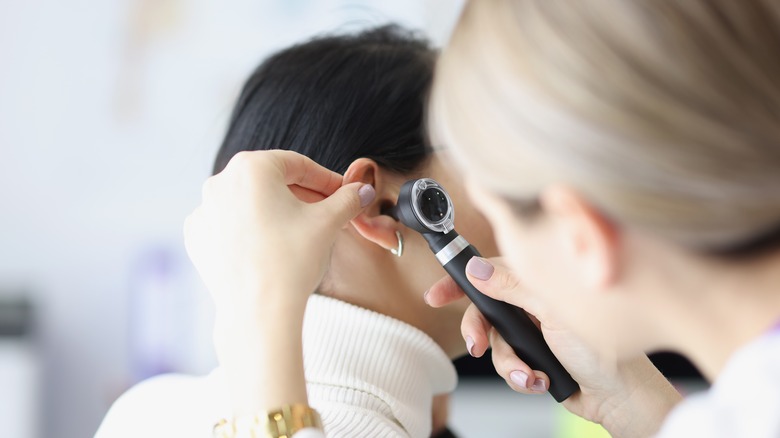What You Should Know About Ear Infections In Adults
The ear is made up of three main parts — the inner, middle, and outer ear (via Johns Hopkins Medicine). Each part plays a major role in hearing, but ear infections can sometimes occur, causing certain parts to malfunction. Although children are the most vulnerable to ear infections, adults can also develop them. When adults get ear infections, it might indicate more serious problems or underlying conditions, according to Healthline. Therefore, it's crucial to know the various causes and symptoms to ensure you receive the right treatment.
Generally speaking, you can get an ear infection when bacteria or viruses trap fluids behind the eardrum, resulting in inflammation (via Cleveland Clinic). Ear infections generally go away independently, but if they keep returning, they're considered to be recurrent, according to MedicalNewsToday. Recurrent ear infections can cause fluid buildup in the middle ear that does not go away. In this case, the ear infection is called chronic or long-term. In general, the type of infection you get might determine the symptoms you experience and the treatment options that can work for you.
Types of ear infections in adults
According to Healthline, there are three types of ear infections. The first is an outer ear infection, also known as otitis externa or swimmer's ear. It's often triggered when water from swimming or bathing gets stuck in the ear, according to Healthline. Over time, the water combined with moisture in your ear makes it easy for harmful bacteria to thrive. Scratching or irritating the outer lining with your fingers or inserting other objects in your ear can also trigger a bacterial infection in the outer ear.
According to Johns Hopkins Medicine, middle ear infections are caused by a cold or allergy, irritating the eustachian tube or causing it to swell. This often prevents fluids from the middle ear from draining. Over time, the fluids build behind the ear drum, enabling bacteria and viruses to grow and infect the middle ear. Smokers and those prone to allergies and colds are more likely to develop middle ear infections, per Johns Hopkins Medicine.
Inner ear infections usually affect the structures of the inner ear, causing it to become inflamed, per MedicalNewsToday. Several causes contribute to inner ear infections, with viral and bacterial infections being the most common, especially in female adults between 30 and 60 years. Some inner ear infection cases can be an extension of a problem in the middle ear due to the proximity.
Symptoms of adult ear infections
According to the National Health Service (NHS), people with ear infections often develop mild symptoms that clear up on their own. Some common symptoms include ear pain, difficulty hearing, ear discharge, itchiness, swelling, irritation, or redness around the ear, which develops into scaly skin.
With some ear infections, you might experience nausea, ear drainage, or an unexplained heavy feeling in the ear (via WebMD). However, ear infections can also result in more severe symptoms, including the enlargement or swelling of the lymph nodes in front or behind the ears. This can cause you to be feverish or experience severe ear pain, according to Healthline. Lymph nodes play an active role as part of the immune system, ridding your body of harmful substances, per Healthline.
If you're battling an inner ear infection, you might also experience unexplained dizziness. Inner ear infections like labyrinthitis affect the cochlea, which sends sound waves and signals to the brain's language processing areas. According to the NHS, an infection can throw these signals out of sync, confusing your brain and leading to symptoms like loss of balance.
When to see a doctor
The symptoms of ear infections can be unbearable, making it difficult to sleep, eat, or go about your daily activities. However, many ear infections resolve independently, so you can opt to wait and see how things progress. A 2017 study published in the American Journal of Nursing reiterates that the wait-and-see approach can be a great way to lessen the burden of acute otitis and reduce the unnecessary prescribing of antibiotics. A significant part of the wait-and-see approach depends on how fast ear infection symptoms resolve. Therefore, not seeing the doctor while symptoms keep worsening can be dangerous.
According to Healthline, if your ear infection comes with a fever, you should seek medical help. The same applies if fluids begin to drain from your ears, muffling your hearing ability. The Centers for Disease Control and Prevention (CDC) also advises seeking medical help when symptoms begin to worsen and your temperature exceeds 102.2 degrees Fahrenheit.
Also, try to remember the number the days from when you experienced your first symptoms. The longer you leave your symptoms unattended to by a health expert, the more you increase your risk of the long-term complications of ear infections. These include permanent hearing loss, cholesteatoma, inflammation of the brain, and facial paralysis (via Penn Medicine).
How are ear infections diagnosed?
In addition to doctors, audiologists and otolaryngologists can diagnose ear infections. According to WebMD, your doctor can monitor the inside of your ear with an otoscope, a specialized tool with a tiny flashlight and a magnifying lens. If your eardrum is pinkish-grey, this indicates that it's healthy. An infected eardrum might appear reddish or swollen.
According to Healthline, the otoscopic examination can diagnose more symptoms, including bubbles in the middle ear and a perforated or collapsed eardrum. However, your doctor can run further tests, including a hearing test if your infections are chronic. A fluid sample test can determine the existence of certain types of antibiotic-resistant bacteria. Doctors can request a sample containing pus, wax, or blood from the ear for a drainage culture test, which helps detect infection-causing germs in the ear, per the University of California San Francisco Health.
According to the American Speech-Language-Hearing Association, a tympanometry test can help diagnose ear infections by examining the health of the eardrum. An audiologist can insert a probe into each ear that projects your eardrum's movement unto a tympanogram. Based on how the eardrum moves, the audiologist can tell if you have middle ear fluid, holes in your eardrum, or wax in your ear canal.
Ear infection treatment options
The options for treating ear infections vary. If your diagnosis reveals bacteria as the cause of your ear infection, your doctor might prescribe antibiotics. To relieve any pain, your doctor might offer pain medications like acetaminophen (Tylenol) or ibuprofen (Advil) to help manage the painful and feverish symptoms companies by your ear infections (via WebMD).
According to MedicalNewsToday, nonprescription eardrops may help with mild cases of swimmer's ear or outer ear infections. Also, drugs like pseudoephedrine or diphenhydramine may help treat ear infections caused by excess mucus in the eustachian tubes. These drugs belong to special pharmaceutical classes of drugs called histamines and decongestants, which are commonly used in treating otitis media with effusion, according to a 2011 study published in The Cochrane Library.
Generally speaking, it's vital to get the right treatment as soon as possible. Ear infections may cause serious implications like ear bleeding or barotrauma in some people, as noted by the Cleveland Clinic. In such cases, your doctor may recommend a surgical procedure called a myringotomy. It's usually performed by an ear, nose, and throat specialist to drain fluids trapped in your middle ear.






